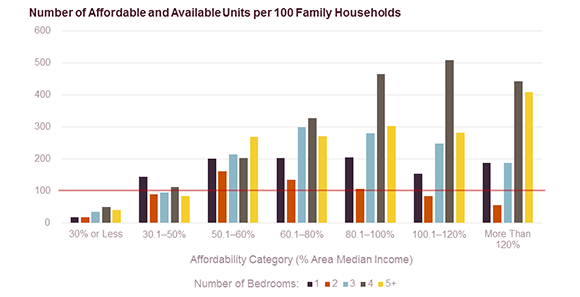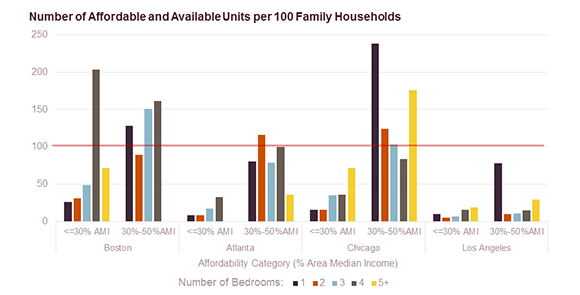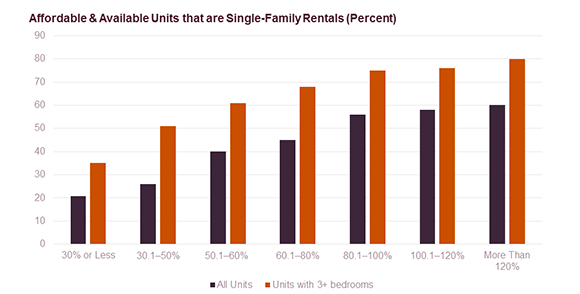American Families Can’t Afford the Rent
Housing is a central component of family life and can provide a foundation for family well-being. While we typically think of family households as homeowners, renters are, in fact, more likely than homeowners to have children in their household. Many low-income households struggle to find affordable housing, but for low-income households with children, the search for an affordable, right-sized, and safe unit can be an even greater challenge.
In a new paper, we quantify the gap in the supply of family-friendly rental units for households with children at all income levels and across different geographies, finding wide deficits in availability at the lowest income levels, and higher up the income ladder in some metros. Additionally, we examine the important role that single-family rentals play in providing affordable, family-sized units.
While there are many dimensions to family-friendly housing, we focus on three elements: affordability, size, and availability. Units are affordable if the household does not spend more than 30 percent of its income on rent and utilities. We consider units to be right-sized if there is at least one bedroom for every two people in the household. Finally, units must be available, meaning that they are not occupied by a higher-income household that could afford a more expensive unit and are also not occupied by a household with no children. All households deserve affordable, safe, and appropriately-sized housing; the purpose of our analysis is only to assess the supply available to families with children given competing needs from other households for the same-priced units.
To estimate the supply gap, we calculate the number of affordable and available units in each income category, expressed as a percentage of area median income (AMI), by unit size. We then take the number of households with children in each income category by household size and estimate the number of bedrooms each household would need. The gap is simply the difference between the number of units that are affordable and available in each income band and unit size and the number of family households needing those units.
We find that the gap is largest for extremely low-income families (ELI) making up to 30 percent of AMI (Figure 1). There are 3.1 million ELI renter households with children and 3.2 million units with at least one bedroom affordable to ELI renter families. Thus, for every 100 ELI renter families, there are 105 affordable units in our study sample. However, only 22 of these units are both affordable and available for every 100 ELI renter families, amounting to a deficit of 2.4 million units. The greatest need is for two-bedroom homes, which have a gap of 1.4 million units.
Figure 1: The supply gap is largest for extremely low-income renter families
Source: JCHS tabulations of US Census Bureau, 2015 American Community Survey 1-Year Estimates.
The supply gap is present in all regions of the country (Figure 2). The gap is largest in the West, where the number of ELI families outnumbers the affordable, right-sized, available supply by about 611,000 units. In this region, only 13 of every 100 ELI families have the possibility of accessing suitable rental housing, and the supply gap extends into units affordable to very low-income (VLI) families making up to 50 percent AMI. The Northeast has the least severe supply deficit, with 29 family-friendly units for every 100 ELI families.
Figure 2: All regions have extremely low-income supply gaps
Source: JCHS tabulations of US Census Bureau, 2015 American Community Survey 1-Year Estimates.
We also looked at the supply gap in four metropolitan areas: Atlanta, Boston, Chicago, and Los Angeles (Figure 3). While Boston has high median rents, it had the lowest gap for ELI families, likely due to the large stock of subsidized rental housing in this metro. Even still, only 36 family-friendly units exists for every 100 ELI families. The deficit amounts to 38,000 units. In Los Angeles, the deficit is severe for ELI families and climbs the income ladder all the way up to larger units affordable at 100 to 120 percent AMI. The ELI deficit tops 124,000 units, leaving only seven suitable units for every 100 families. Across all income categories, the total supply gap is more than 300,000 units.
Figure 3: Boston and Chicago have smaller affordable supply gaps than Atlanta and Los Angeles
Source: JCHS tabulations of US Census Bureau, 2015 American Community Survey 1-Year Estimates.
Finally, we found that single-family rentals are an important source of family-friendly housing nationally (Figure 4). Single-family rentals make up about a fifth of the units that are affordable and available to ELI and VLI households with children, particularly larger-sized homes with more bedrooms that likely are less desirable to other household types. The share of single-family rentals increases with each affordability category. Western metros encompass an outsized share of single-family rentals at higher affordability thresholds, while the Midwest and Northeast have disproportionate shares of lower-cost single-family rentals.
Figure 4: Single-family rentals make up a substantial share of affordable and available family-sized housing
Source: JCHS tabulations of US Census Bureau, 2015 American Community Survey 1-Year Estimates.
There is a deep need for affordable, right-sized rental units for families across the country. The need for larger units in the lowest affordability categories is likely understated in our paper given our methods for assigning family households to housing units. Due to the complexity of estimating different families’ particular housing needs (given different configurations of ages and genders), we simply assigned every two people in a household to a single bedroom. Since a single parent with one child might prefer a two bedroom unit, and children sharing bedrooms may not be practical or desirable in all cases, it is likely that our estimates of supply deficits are conservative.
Yet even if they do underestimate the supply gap, the findings underscore the importance of increasing the public and private low-income rental supply and providing assistance for families in the private rental market. At the federal level, the expansion of household-based rental assistance would increase options for ELI families. At the local level, communities that have inclusionary housing programs might consider requiring that a certain share of units be sized for families. Municipalities might also evaluate whether putting resources into affordable housing for students or young professionals would reduce some of the competition for family-friendly rental housing.





